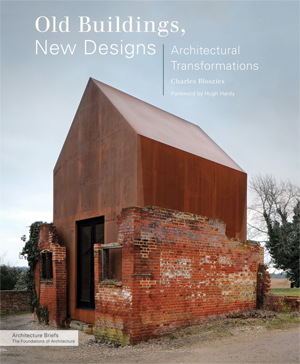Architectural hybrids are all around us. Most historic buildings are now, in fact, examples of additive architecture. But after the schism of modern architecture, making a claim for additions as valid contemporary architecture amounts to a manifesto. A book on this subject, and about the exciting work being produced right now, is sorely needed. This is not that book.

Aiming to “explore the union of new and old architecture,” Old Buildings, New Designs is one of a number or recent publications on the question of re-use. But the subject awaits a deeper understanding of the architectural power of the combination of the old and the new. This book does not provide a broad, insightful critical review of the issues at hand either from a contemporary viewpoint or from a historical perspective. Fred Scott’s On Altering Architecture (Routledge, 2008) provides a more informed critical discussion, and R. Klanten’s Build-On — Converted Architecture and Transformed Buildings (Gestalten, 2009) offers a more stimulating visual presentation of similar material.
Bloszies’ book is roughly divided in two sections. The first half reviews general questions, such as the “Appeal Of Old Buildings,” “Critical Components For Urban Sustainability,” and “The Question Of Context,” which tend to reiterate existing ideas. And there are also critical errors, such as the statement in an end note: “Responsibility for preservation of historic structures in the United States lies within the National Parks Service under the umbrella of the Secretary of the Interior." In fact, the Secretary of the Interior Standards do not have the force of law. According to the opening paragraph of the Standards themselves, the guidelines simply provide “philosophical consistency to the work.”
The second half of the book contains 19 case studies, two of which are on buildings designed by the author. Classifying the case studies as “Small Interventions,” “Major Additions,” “Repurposed Buildings,” or “None of the Above” is not helpful. Most projects are presented without plans or sections; many have only one or two illustrations. Some photographs are unidentified, many poorly printed. The Selexyz Domenicanen Bookstore in Maastricht, the Netherlands, which happens to be a truly outstanding example of additive architecture involving the insertion of a modern bookstore in a 13th century church, is illustrated with only one photograph (no floor plan or section) and described with limited commentary. It is not clear whether the author has seen the building (he does not disclose which buildings he has visited), but if he had, I suspect he would have mentioned the extraordinary new entrance door. Inexplicably, this project is omitted from the end notes so that the reader cannot refer to other books where it has been covered more fully.
The author argues that “design integrity” consists of the clear legibility of the old and the new, preferably through contrast (mistakenly invoking Robert Venturi). If this is the standard by which we are to judge a successful addition, what are we to make of James Stewart Polshek’s masterful 1984 addition to SOM’s 1960 Pepsi Cola Headquarters in New York City, which is designed in a modern mode so compatible with the original building that it takes a trained eye to distinguish them? Surely the critical examination of the architecture of additions cannot be so simplistically reduced to one simple rule (legibility through contrast). For me, the fascination of additive architecture is that it cannot, by its very nature, be dogmatic and is therefore endlessly inventive and varied — therein lies its power and its freedom.
